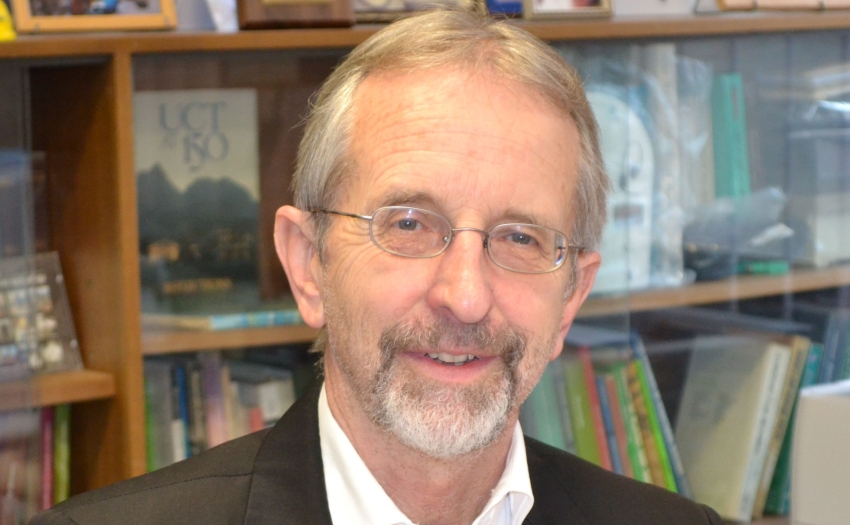News

Interview series with RILEM prominent members: Prof. Mark Alexander
Prof. Mark Alexander is Emeritus Professor and Senior Research Scholar at the University of Cape Town, South Africa. Prof. Alexander served as TAC expert between 2000 and 2005 and as Bureau member between 2005 and 2009. He was then elected as Vice President in 2009 and took over the mandate as President in 2012. From 2015 to 2018 he served as Immediate Past President of RILEM. Prof. Alexander was also elected RILEM Fellow in 2009, RILEM Honorary President in 2012 and RILEM Honorary member in 2016. He chaired the following TCs: 159-ETC: Engineering of the interfacial transition zone in cementitious composites, and 211-PAE: Performance of cement-based materials in aggressive aqueous environments.
6 December 2021
RILEM Implementation Manager (RIM): Do you remember when you joined RILEM?
Prof. Mark Alexander (MA): I tried to go back and find out exactly when I joined. I think it would have been in the late 80’s. So, roughly 30-35 years ago. I am afraid I was not able to determine the exact data.
RIM: Where were you in your career when you joined RILEM?
MA: I was a very young researcher. I was not even a professor. I have always said that for a young researcher like me in the southern part of Africa, if you want to make progress you have to become visible. Much of the research was carried out either in Europe or the US, but Europe was a far more sensible partner because of many historical associations with Europe that we have. Furthermore, I had some really fantastic people who helped me in my early career. People like Arnon Bentur, long time RILEM member, who helped me to get involved in the association. He encouraged me to do that!
RIM: Having a look at the RILEM data, you appear for the first time in the system in 1993, when you became the Chair of the Technical Committee 159-ETC Engineering of the interfacial transition zone in cementitious composites. Do you remember this?
MA: Yes! I remember very well! It was a very daunting experience. I think I still bear the scars of that TC. It was a tricky one. Arnon Bentur and I were co-chairs of that Committee (Editor’s note: nowadays a TC has a Chair and a Deputy-Chair. In the past, it might have had 2 co-chairs). At that time, some work was being done in France, largely in Toulouse, and elsewhere in the world. RILEM was in a state of tension between the Franco-dominated sector, with strong French influence, and the rest of the world that was beginning to flex its muscles. We had two TCs, actually, that we had to run in coordination. It was a great experience in “human relationship”, how to make things work when there were two very strong camps who each had their own idea and you had to give space to both of those. I have always thought that coming from South Africa, where we had to negotiate our difficult past many times over, maybe gave me an advantage handling that diversity and tension which was not easy to handle. It was a very formative experience. Technically, it was a great committee to be in, but just in terms of governance and how to chair it… it was very tricky. I have a very strong recollection of that committee.
RIM: Do you remember your first RILEM event?
MA: Other than TC-159, I remember it was in 2001, in Stuttgart, Germany (Editor’s note: the 55th RILEM Annual week and the International RILEM Symposium on connections between steel and concrete. Proceedings available here). I remember going to a workshop organised by Prof. Reinhardt and at the same time attending the RILEM week as an observer when the General Council met. That was very interesting. It was also an absolutely incredible week because that was the week of 9/11. One day we came back from a meeting, turned on the TV and saw the Twin Towers coming down. We couldn’t believe it. it was a stunning and staggering thing. Some of us met for dinner that night and we couldn’t talk about anything else. There was then the problem of how to get home as all flights were cancelled. I was able to get home without many difficulties as I was not flying back through North America, but people flying there had to spend weeks or more before going home.
RIM: In Materials and Structures, I found a paper published in 1985 titled Towards standard tests for abrasion resistance of concrete: report on a limited number of tests studied, with a critical evaluation.
MA: That was the first paper I ever published in a RILEM journal, and it also grew out of an association with Prof. Bentur. At that time, I didn’t even have a PhD. He took me on in his laboratory in Technion, Haifa, Israel, and we worked together on abrasion testing. That is again an example of how an established RILEM member was able to encourage a younger member and ensure the future of my involvement in RILEM. It is an investment in human capacity and development and bore fruit over the years. In fact, that was my first association with RILEM and I think it was about that time if not soon after that I joined RILEM.
RIM: In 2000 you became TAC expert.
MA: Yes! I was also involved in what was called the Coordinating Committee, that was really the forerunner of the Development Advisory Committee (DAC). We had a different committee structure then. This is detailed in the last RILEM History booklet that we produced this year (Editor’s note: further details on this matter are available on page 10 of the 75th RILEM Anniversary booklet). It was again a very formative experience that helped me to better understand RILEM, but also it was a period of RILEM in which big decisions had to be taken to move the organization forward.
RIM: After having experienced the work of TC 159-ETC and the Coordinating Committee, was it a piece of cake when you finally became the RILEM Vice-President in 2009? Was that the easy part in your management role in RILEM?
MA: In many ways, you are quite correct. By the time I became RILEM Vice-President, many of the issues that were holding RILEM back during the first decade of this century, had been resolved. Issues about finance (we were always short of money at that time!) or about the overall governance of the association were resolved by several very bold Presidents such as Ake Skarendahl, Carmen Andrade, Arnon Bentur and Peter Richner. All of these had a huge influence. I reaped the benefits, to be honest.
RIM: Which were the major changes in RILEM while you were President?
MA: We were suddenly launched in a new trajectory: we had greater input from members, greater international appeal as we were moving away from a Franco-centric and Euro-centric association to try to make our presence felt all over the world. We were “free” to do that, as we begun to have different funding models, outreach, and other types of activities. During my presidency I had the enormous pleasure and privilege of signing a whole bunch of memoranda of understanding with concrete or similar associations around the world. That was quite remarkable, and people were queuing up as they wanted to be associated with RILEM. It was a period of very exciting growth and internationalization that we experienced at that time. A very unique period for me and one which I was very privileged to be part of.
RIM: I can see another milestone in your RILEM career when you became RILEM Honorary member in 2016. Are you still an active member?
MA: I am still an active member, yes! I have always said that the trick in any career is to know when to leave. At the end of my past-presidency it was time to step down, but I progressed to becoming an active TC member again. So, I am still involved in a couple of TCs. I am getting back to the core business of what RILEM does and for me, this is a very satisfactory way to continue my career in RILEM and to continue many friendships with people in RILEM that I got to know through the years. RILEM really has given me a window on the world including the scientific world, and it brought me in contact with so many people that now I address at a personal level.
RIM: What would be the major outcomes of your work that would be of interest to RILEM members?
MA: I think that the TC 211-PAE: Performance of cement-based materials in aggressive aqueous environments was a very successful committee. I still remember it with a lot of pleasure. But also I had two excellent working group convenors: Alexandra Bertron and Nele De Belie. For Alexandra and Nele, that was really in many ways an introduction to RILEM. We were able to bring them in and immediately they established their strengths and they helped to make that committee a real success. The State-of-the-Art Report (STAR) published by that TC is still one of the top Springer sellers and you made a resume of that report (Editor’s note: STAR-in-a-Nutshell of STAR 211-PAE is available here).
RIM: Which is the most impactful paper that you have published in Materials and Structures? I had a look online and I found that A framework for use of durability indexes in performance-based design and specifications for reinforced concrete structures, that you published with Y. Ballim and K. Stanish in 2008 was accessed 1206 times and cited 144 times.
MA: I think that from the point of view of laying the foundations of the research work we have been busy with in the last few decades, this was a seminal paper that laid the philosophical framework for the research to be done in that area for quite a long time. Interesting, there is another paper in acid resistance of sewer concrete pipes (Editor’s note: Alexander, M.G., Fourie, C. Performance of sewer pipe concrete mixtures with portland and calcium aluminate cements subject to mineral and biogenic acid attack. Mater Struct 44, 313–330 (2011)), co-authored with one of my students. That paper was also very well cited. You publish these things and then they get a life of their own, in terms of access and citations. What you think is your best paper, doesn’t always turn out to be that way.
RIM: I was very interested in your paper with Alice Bakera, who is the first author of a publication on RILEM Technical Letters (Editor’s note: Bakera, A. T.; Alexander, M. G. Use of Metakaolin As Supplementary Cementitious Material in Concrete, With Focus on Durability Properties. RILEM Tech Lett 2019, 4, 89-102). Alice is a PhD student. It is really remarkable to see a PhD supervisor giving space to a PhD student to be the first author of a publication, acknowledging the work done. Unfortunately, this is not always the case.
MA: She is still a PhD student, finishing soon. That paper was not even based on her PhD studies, but her Master’s thesis. Well, I mean… it is her work. I made a contribution, but it was her work, and she must get the credit for it. I have always seen my role as a professor to promote young people, giving them an opportunity. Knowledge creation is important, and we do that, but we do it through the agency of students. And to be honest, the students are the ones that come up with the greatest ideas, in my experience.
RIM: What does RILEM mean for you?
MA: It means many things, and I have discussed a lot of them already. But it also means the ability of discussing openly. Now and then you get cases where discussion is tiresome but almost never in my opinion has this happened. There is a genuine openness to debate and discussion within the association. People are not defending territories, in the main. This is important to me, and we must keep that sense of open discussion. Furthermore, RILEM has a great ability to engage with the critical and technical issues of the day, the burning technical issues, such as climate change, sustainability, use of construction materials. There is also the sense of being part of the core of the scientific community involved in critical issues. That is very important and also something that the younger researchers really appreciate in RILEM. Finally, the positive coordination that occurs across the association through the work of the standing committees, a common whole bigger than the sum of its parts.
RIM: I have one final question for you: do you think RILEM is doing enough to engage researchers and young scholars from Africa?
MA: This is a difficult issue. You cannot look at Africa as a homogenous continent. It is a highly diverse continent. The opportunities from country to county and from region to region differ enormously. The challenges are as diverse as the continent itself. I think that we must keep doing what we are doing. Regarding the big issue of funding opportunities, this is not something that RILEM should address, but the governments. Slowly this is happening but it is taking longer than we might have liked. I am modestly confident that we will see a change in the next 10 years.
RIM: We all look forward to this change. Thank you for your time today.
MA: Thank you, I am very grateful for this. Stay well, Daniela! Ciao!














No comment
Log in to post comment. Log in.